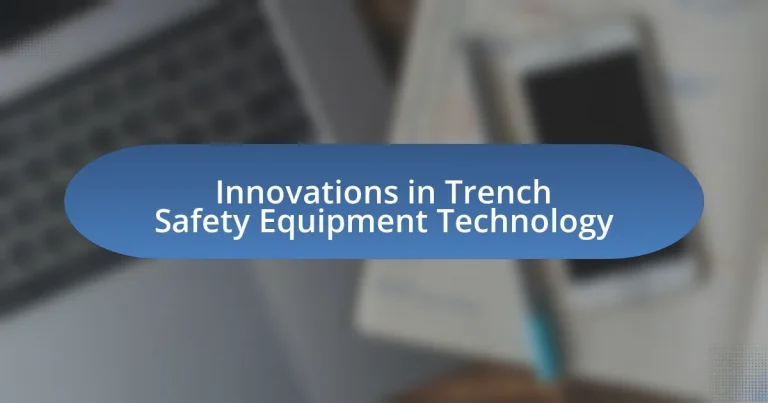Innovations in trench safety equipment technology focus on advanced trench boxes, hydraulic shoring systems, and smart monitoring devices designed to enhance worker safety and efficiency in excavation operations. Recent advancements integrate sensor technology and lightweight materials, significantly improving the design and functionality of safety equipment. Key innovations include real-time monitoring systems that assess soil stability and environmental conditions, as well as modular designs that facilitate easier transport and setup. The article also discusses the critical role of regulations, such as those from OSHA, in driving these technological advancements and ensuring compliance to mitigate common hazards associated with trench work.

What are Innovations in Trench Safety Equipment Technology?
Innovations in trench safety equipment technology include the development of advanced trench boxes, hydraulic shoring systems, and smart monitoring devices. Advanced trench boxes are designed with lightweight materials and modular designs, allowing for easier transport and setup while providing enhanced protection against collapses. Hydraulic shoring systems utilize hydraulic pressure to support trench walls, offering adjustable support that can adapt to varying soil conditions. Smart monitoring devices, equipped with sensors, provide real-time data on soil stability and environmental conditions, enabling proactive safety measures. These innovations collectively enhance worker safety and efficiency in trenching operations.
How have recent advancements changed trench safety equipment?
Recent advancements have significantly improved trench safety equipment by integrating smart technology and enhanced materials. Innovations such as trench boxes equipped with sensors now monitor soil conditions and detect potential hazards in real-time, thereby increasing worker safety. Additionally, the use of lightweight, durable materials has made equipment easier to transport and set up, while also providing better protection against collapses. For instance, the introduction of advanced shoring systems has reduced the risk of trench failures by up to 50%, according to industry studies. These advancements reflect a commitment to enhancing safety standards in excavation work.
What technologies are driving these innovations?
Innovations in trench safety equipment technology are primarily driven by advancements in sensor technology, artificial intelligence, and materials science. Sensor technology enables real-time monitoring of environmental conditions and structural integrity, enhancing safety measures. Artificial intelligence algorithms analyze data from these sensors to predict potential hazards and optimize safety protocols. Materials science contributes by developing lightweight, durable materials that improve the design and functionality of safety equipment. These technologies collectively enhance the effectiveness and reliability of trench safety solutions, reducing the risk of accidents in excavation sites.
How do these advancements improve worker safety?
Advancements in trench safety equipment technology significantly improve worker safety by enhancing protective measures and reducing the risk of accidents. For instance, the introduction of trench boxes and shoring systems provides critical support to prevent collapses, which are a leading cause of fatalities in trench work. According to the Occupational Safety and Health Administration (OSHA), trench collapses can occur within seconds, making proper equipment essential for immediate protection. Additionally, innovations such as real-time monitoring systems and wearable technology allow for continuous assessment of soil conditions and worker health, further mitigating hazards. These advancements collectively contribute to a safer working environment by addressing the primary risks associated with trenching operations.
Why is trench safety equipment critical in construction?
Trench safety equipment is critical in construction because it prevents accidents and fatalities associated with trench collapses. According to the Occupational Safety and Health Administration (OSHA), trench collapses can occur within seconds, and they pose significant risks to workers, with approximately 1 in 10 trench-related fatalities resulting from such incidents. The use of safety equipment, such as trench boxes and shoring systems, mitigates these risks by providing structural support and protecting workers from cave-ins. Furthermore, the implementation of trench safety protocols and equipment is mandated by regulations, emphasizing its importance in ensuring worker safety and compliance in construction environments.
What are the common hazards associated with trench work?
Common hazards associated with trench work include cave-ins, falls, hazardous atmospheres, and equipment-related incidents. Cave-ins are the most significant risk, with the potential to bury workers under tons of soil; according to the Occupational Safety and Health Administration (OSHA), approximately 75% of trench-related fatalities result from cave-ins. Falls into trenches can occur due to unprotected edges or improper access, while hazardous atmospheres may arise from the presence of toxic gases or low oxygen levels. Additionally, equipment-related incidents can happen when machinery operates near the trench, posing risks to workers. These hazards highlight the critical need for effective safety measures and equipment innovations in trench work.
How does trench safety equipment mitigate these hazards?
Trench safety equipment mitigates hazards by providing structural support and protective measures that prevent collapses and protect workers from falling objects. For instance, trench boxes and shoring systems are designed to stabilize the walls of excavations, reducing the risk of cave-ins, which are a leading cause of fatalities in trench work, accounting for approximately 75% of trench-related deaths according to the Occupational Safety and Health Administration (OSHA). Additionally, personal protective equipment (PPE) such as hard hats and safety vests enhances worker safety by increasing visibility and protecting against head injuries from falling debris. These innovations in trench safety equipment are crucial in creating a safer work environment and significantly lowering the incidence of accidents in trenching operations.

What types of trench safety equipment are currently available?
Currently available types of trench safety equipment include trench boxes, trench shields, and shoring systems. Trench boxes are designed to protect workers from cave-ins by providing a safe working environment within the trench. Trench shields serve a similar purpose but are typically lighter and easier to transport. Shoring systems, which can be hydraulic or mechanical, are used to support the walls of the trench and prevent collapses. According to the Occupational Safety and Health Administration (OSHA), proper use of these safety devices significantly reduces the risk of trench-related accidents, highlighting their importance in construction safety protocols.
What are the key categories of trench safety equipment?
The key categories of trench safety equipment include protective systems, monitoring devices, and personal protective equipment (PPE). Protective systems, such as trench boxes and shoring systems, are designed to prevent collapses and protect workers. Monitoring devices, including gas detectors and depth gauges, ensure safe working conditions by detecting hazardous gases and measuring trench depth. Personal protective equipment, such as hard hats, safety vests, and steel-toed boots, provides individual safety for workers in trench environments. These categories are essential for minimizing risks associated with trench work, as outlined by safety regulations and industry standards.
How do protective systems differ from monitoring systems?
Protective systems are designed to prevent accidents and injuries in trench environments, while monitoring systems focus on tracking conditions and detecting potential hazards. Protective systems, such as trench boxes or shoring, physically support the trench walls to prevent collapses, ensuring worker safety. In contrast, monitoring systems utilize sensors and alarms to provide real-time data on environmental conditions, such as soil stability and gas levels, allowing for timely interventions. The distinction lies in the proactive nature of protective systems versus the reactive nature of monitoring systems, which is crucial for maintaining safety in trench operations.
What role do personal protective equipment (PPE) play in trench safety?
Personal protective equipment (PPE) plays a critical role in trench safety by providing essential protection against hazards such as falling objects, exposure to hazardous materials, and potential trench collapses. PPE, including hard hats, gloves, high-visibility clothing, and respiratory protection, is designed to minimize the risk of injury and enhance worker safety in environments where trenching operations occur. According to the Occupational Safety and Health Administration (OSHA), proper use of PPE can significantly reduce the likelihood of injuries, with statistics indicating that wearing appropriate gear decreases the risk of serious injuries by up to 70%.
What are the latest innovations in specific trench safety equipment?
The latest innovations in trench safety equipment include advanced trench boxes with integrated sensors, which monitor soil conditions and provide real-time alerts for potential collapses. These trench boxes utilize smart technology to assess the stability of the surrounding earth, enhancing worker safety by allowing for immediate action if hazardous conditions are detected. Additionally, new lightweight, modular shoring systems have been developed, allowing for quicker setup and increased portability, which improves efficiency on job sites. These innovations are supported by industry studies indicating that the use of smart technology in trench safety can reduce accidents by up to 30%, demonstrating their effectiveness in enhancing safety protocols.
How have trench boxes evolved in design and functionality?
Trench boxes have evolved significantly in design and functionality to enhance worker safety and efficiency in excavation sites. Initially, trench boxes were simple, rectangular structures made of steel or aluminum, primarily designed to prevent soil collapse. Modern trench boxes now incorporate advanced engineering techniques, such as modular designs that allow for easy assembly and disassembly, improving transportability and adaptability to various trench sizes.
Additionally, contemporary trench boxes often feature integrated safety systems, including hydraulic shoring mechanisms that provide adjustable support and real-time monitoring of soil conditions. These innovations are supported by industry standards, such as those from the Occupational Safety and Health Administration (OSHA), which emphasize the importance of protective systems in trenching operations. The evolution reflects a broader trend towards prioritizing safety and efficiency in construction practices, driven by technological advancements and regulatory requirements.
What advancements have been made in trench shoring systems?
Recent advancements in trench shoring systems include the development of lightweight, modular aluminum shoring systems that enhance portability and ease of installation. These systems are designed to meet stringent safety standards, such as those set by OSHA, and incorporate features like adjustable heights and integrated safety rails. Additionally, advancements in technology have led to the use of hydraulic shoring systems that provide greater stability and can be quickly deployed in various soil conditions. The introduction of smart sensors in some shoring systems allows for real-time monitoring of soil pressure and structural integrity, significantly improving safety measures on job sites.

How do regulations influence innovations in trench safety equipment technology?
Regulations significantly drive innovations in trench safety equipment technology by establishing mandatory safety standards that manufacturers must meet. These regulations, such as those set by the Occupational Safety and Health Administration (OSHA), compel companies to develop advanced safety solutions, including trench boxes and shoring systems, to protect workers from cave-ins and other hazards. For instance, OSHA’s standards require protective systems for trenches deeper than five feet, leading to the creation of lightweight, modular trench safety equipment that enhances both safety and ease of use. This regulatory framework not only fosters technological advancements but also encourages ongoing research and development in the field, ensuring that safety equipment evolves in response to emerging risks and industry needs.
What are the key regulations governing trench safety?
The key regulations governing trench safety include the Occupational Safety and Health Administration (OSHA) standards, specifically 29 CFR 1926 Subpart P, which outlines requirements for excavation and trenching operations. These regulations mandate protective systems for trenches deeper than five feet, including trench boxes or shoring, to prevent cave-ins. Additionally, the regulations require regular inspections by a competent person to identify hazards and ensure compliance with safety measures. OSHA’s guidelines are supported by data indicating that proper adherence to these regulations significantly reduces the risk of accidents and fatalities in trenching operations.
How do these regulations drive technological advancements?
Regulations drive technological advancements in trench safety equipment by establishing mandatory safety standards that compel manufacturers to innovate. For instance, regulations such as the Occupational Safety and Health Administration (OSHA) standards require the implementation of protective measures like trench boxes and shoring systems, which leads companies to develop more effective and efficient safety technologies. The need to comply with these regulations often results in the creation of advanced materials and designs that enhance worker safety, as evidenced by the introduction of lightweight, high-strength composite materials in trench safety equipment. This regulatory pressure not only fosters innovation but also accelerates the adoption of new technologies in the industry.
What impact do compliance requirements have on equipment design?
Compliance requirements significantly influence equipment design by mandating adherence to safety standards and regulations. These requirements ensure that equipment is built to minimize risks, enhance user safety, and meet legal obligations. For instance, the Occupational Safety and Health Administration (OSHA) sets specific guidelines for trench safety equipment, which necessitates that manufacturers incorporate features such as protective systems and safety barriers. This regulatory framework drives innovation, compelling designers to develop advanced materials and technologies that not only comply with safety standards but also improve functionality and efficiency in trench safety equipment.
How can companies effectively implement new trench safety technologies?
Companies can effectively implement new trench safety technologies by conducting thorough training programs for employees, integrating advanced monitoring systems, and ensuring compliance with safety regulations. Training programs equip workers with the necessary skills to use new technologies safely and effectively, which is crucial given that improper use can lead to accidents. Advanced monitoring systems, such as real-time sensors and alarms, enhance safety by providing immediate feedback on trench conditions, thereby reducing the risk of collapses. Compliance with safety regulations, such as those set by OSHA, ensures that the technologies meet industry standards, which is essential for minimizing liability and promoting a culture of safety.
What training is necessary for workers to adapt to new technologies?
Workers need training in technical skills, safety protocols, and equipment operation to adapt to new technologies in trench safety equipment. This training should include hands-on experience with the latest tools and technologies, understanding the functionality of advanced safety equipment, and compliance with updated safety regulations. For instance, the National Institute for Occupational Safety and Health (NIOSH) emphasizes the importance of training programs that incorporate real-world scenarios and simulations to enhance workers’ ability to respond effectively to new safety technologies.
How can companies assess the effectiveness of new trench safety equipment?
Companies can assess the effectiveness of new trench safety equipment by conducting field tests and analyzing incident reports. Field tests allow companies to evaluate the equipment’s performance in real-world conditions, ensuring it meets safety standards and operational requirements. Analyzing incident reports provides data on previous trench-related accidents, helping to identify whether the new equipment reduces risks and enhances worker safety. For instance, a study by the National Institute for Occupational Safety and Health (NIOSH) found that implementing advanced trench safety systems led to a 30% decrease in accidents, demonstrating the potential effectiveness of such innovations.
What best practices should be followed for trench safety equipment usage?
Best practices for trench safety equipment usage include ensuring proper training for all personnel involved, regularly inspecting equipment for defects, and adhering to established safety regulations. Training equips workers with knowledge about the risks associated with trench work and the correct use of safety gear, which is essential for preventing accidents. Regular inspections of trench boxes, shoring systems, and personal protective equipment (PPE) help identify potential failures before they lead to incidents. Compliance with OSHA regulations, which mandate specific safety measures for trenching operations, further reinforces the importance of these practices in maintaining a safe work environment.


